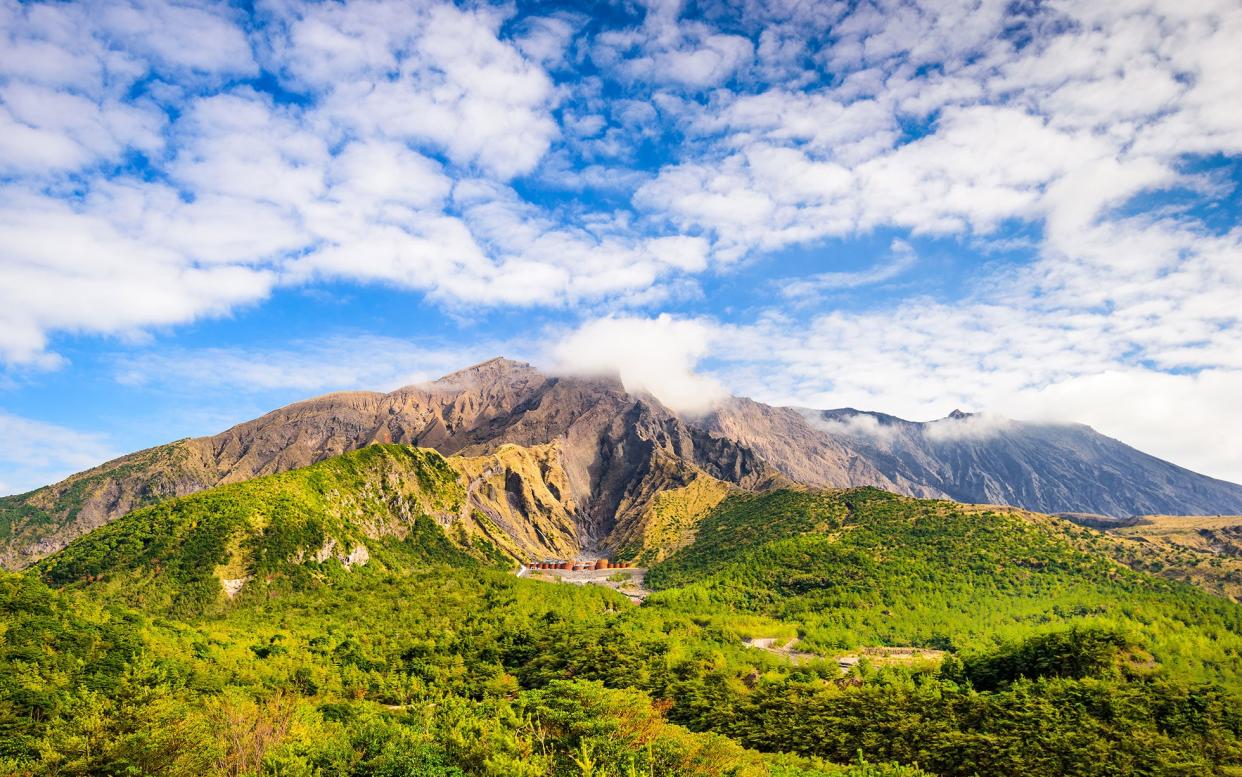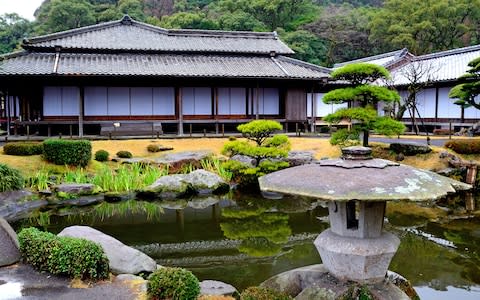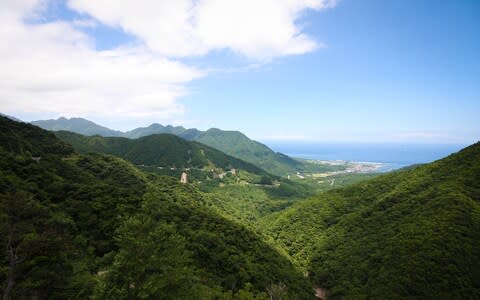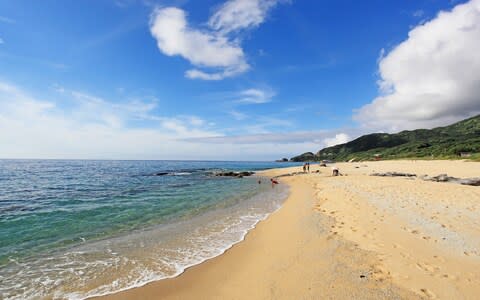The pristine Japanese island that tourists haven't ruined

Japan, we find exactly what we’ve been looking for. My two children and I are standing on a rock at the top of a forest track 3,400ft above sea level and, even though it’s just after lunchtime on a Thursday, there is nobody else in sight.
In fact, in the entire unblemished panorama that stretches before us – distant peaks, a sea of trees, a meandering river – there is not a single visible sign of human intervention. This is the Japan of a thousand woodblock prints; to locate it in reality takes some seeking.
We had begun our trip in Osaka where, on our first morning, we’d looked down from a glass-walled corner suite high in Namba’s Fraser Residence on the cars and crowds making their way through the urban soup along a noodle-like tangle of railways and roads.
With its clamorous shopping arcades and hand-pulled udon joints, Japan’s vibrant second city has much to recommend it as a family holiday destination. But the kind of restorative tranquillity long associated with this country – and for which we’d arrived hungry – is most definitely not on the menu.
Japan (population 127 million) is in the grip of a tourist boom. In 2017, overseas visitor numbers leapt faster than any other country’s. Last year, there were more than 31 million, up from 13.4 million in 2015 and 6.7 million in 2005. With the nation preparing to host a double whammy of sporting events – this autumn’s Rugby World Cup and the 2020 Tokyo Olympics – the numbers are sure to rise further still.

Yet an overwhelming majority of those visitors stick to a well-trodden path, the so-called Golden Route linking Tokyo, Kyoto and Osaka, three of the destinations most frequently identified as victims of “overtourism”. What can the country offer to those prepared to turn their backs on these places? Is there an alternative, more peaceful Japan still waiting to be discovered?
Determined to find out, we board a bullet train that hurtles south past rice fields and fishing villages, castles and convenience stores before depositing us, just in time for lunch, in the port town of Kagoshima – first stop on a tour of Kyushu, the relatively overlooked westernmost of Japan’s four main islands.
At Kurokatsutei – a five-minute walk from the station and famous for its kurobuta (black pork) – almost every other seat is filled by local primary school children in navy uniforms and yellow caps. They are all ordering the 1,000-yen (£7.70) tonkatsu lunch, so we follow suit and are rewarded with a meltingly tender pork fillet in crisp breadcrumbs with rice, shredded cabbage and the house’s lip-smacking special sauce. It’s a meal we could eat happily every day of the year.
From Kagoshima town centre it’s a short bus ride to Sengan-en, a formal garden perched on Kyushu’s southernmost tip, still owned by the Shimadzu family, the feudal clan for which it was constructed 360 years ago. A fee of 1,000 yen (£7.71, half price for children, plus an extra 300 yen for entry to the house) gives access to its manicured acres, home to Japan’s first Chinese bamboo grove, a shrine dedicated to cats, and carpet-soft lawns with dramatic views of Sakurajima, an active volcano a 15-minute ferry trip across the bay.
For the children, there’s also the opportunity to dress as samurai – Kagoshima, a hub for traditional clothing manufacturers, provides the wardrobe for the nation’s TV costume dramas – and engage in a sword fight before tucking into the tea room’s signature dish, a bear-shaped treat made from shaved ice, condensed milk and fruit.

The following morning we take a further leap off the beaten track, and off the mainland, on a high-speed jetfoil to Yakushima.
If there is a better justification for hauling two children halfway around the world than a visit to this magical 120,000-acre island of primeval rainforest and pristine beaches, an island whose 13,000 residents are easily outnumbered by its monkey and deer populations, then I have yet to hear it. The 48 hours we spend on Yakushima leave a greater impression on all four of us than anywhere else on the trip, greater perhaps than anywhere we have ever travelled together.
Within an hour of our arrival, having stashed our luggage in a roadside locker and picked up from the supermarket a picnic of karaage fried chicken and seaweed-wrapped onigiri rice balls, we embark on a gentle four-hour return hike that takes us up through the Shiratani Unsuikyo towards that heart-stopping rocky promontory.
Only later do we learn that the smooth, hollow stone on which we’d stood – then sat, appearing to dangle our feet into the abyss – is called Drum Rock, on account of the noise it makes when struck.
Yakushima’s virgin forest inspired the fairytale scenery of Hayao Miyazaki’s classic animation Princess Mononoke, and the reality is every bit as dreamy. It is said that 70 per cent of all Japan’s plant species can be found on the island; looking at the dense greenery that presses in from all sides, the serpentine roots twisting beneath our feet, it’s easy to believe it.

Following a well-marked circular route, we pass a number of the island’s native towering Yakusugi cedars; one, a particularly gnarled and majestic specimen, is said to be 3,000 years old. Back down at the entrance to the ravine, at dusk, we are asked to add ourselves to a tally of the day’s foreign visitors. There are eight from China, 18 from Hong Kong, nine South Koreans, a dozen Europeans and three North Americans: overtourism, this ain’t.
During our first day on Yakushima, we get around on the local bus, a sporadic service with a friendly driver whose eyes light up when he hears us speaking English. “Ah… Shakespeare!” he says, grinning at me in the rear-view mirror as he trundles past roadside stalls piled high with the island’s ponkan oranges. “Sir Laurence Olivier! Margaret Thatcher!”
On day two, an energetic local guide, Satono Yamazaki from Yakushima Experience, takes us by car to places we otherwise might not have reached, from an invigorating seaside onsen (hot spring) only accessible at low tide, to a Unesco-protected patch of coastal forest in the island’s north-western corner. There we picnic on the forest floor – Yamazaki has brought hearty bento boxes and a flask of guava-leaf tea – near the foot of a venerable banyan tree, a troop of macaques concealed in its branches. Then we complete a circuit of the island’s coastal road, stopping at a sandy beach where, in the summer, loggerhead turtles come to lay their eggs and, even in October, the sea is warm enough to swim in.
That night at Shikinoyado, a family-run refuge which offers tatami-floored rooms that are simple and home-cooked cuisine that is anything but, we feast on glistening mackerel sashimi, flying fish fritters and dragon fruit picked from the garden. Then we bathe in a tub beneath the stars and fall asleep, side by side on futon mattresses, to the thrum of cicadas.
The remainder of our itinerary, tailored for us by Inside Japan, gives us a further taste of Kyushu’s infinite variety: from laid-back Nagasaki, a place that has recovered from the cataclysm of 1945 to become one of the country’s most appealing cities; to Unzen, a charmingly idiosyncratic hot spring resort with a dark history of its own.

In the centre of this mountain town are the so-called “hells” where, through the rocky ground, spout sulphurous jets of steam in which Christian martyrs were once tortured. These days that same volcanic fury is used to fuel the bathing complexes of Unzen’s many hotels.
By the time we reach our final destination, Fukuoka, another easy-going metropolis that appears to have it all – white-sand beaches, a tranquil temple district that feels like a little Kyoto but has none of its crowds, one of the country’s leading baseball teams with its own spectacular stadium, and an international airport with direct flights to Europe – our hearts belong to Kyushu.
We spend our last supper at the counter of a traditional yatai, one of many tiny tented food stalls that materialise each evening on the city’s pavements then vanish without trace long before the morning rush hour.
On the other side of a smoky teppan grill stands the chef, ready to dole out garlicky pork skewers, comforting oden (steamed vegetables in broth), ice-cold bottles of Asahi (or Calpis soda for the kids) and words of wisdom. Since Fukuoka is one of the Rugby World Cup’s dozen host cities, I ask him if he is excited about the event, and ready for the crowds.

In the brief silence that follows, I can almost hear him trying to calculate where, in the rank of compelling reasons to visit Kyushu, watching 30 grown men in shorts marauding across a field might fit. “I’m ready,” he says, flinging a fistful of noodles on to the sizzling grill. “But, well… it just isn’t baseball, is it?”
Essentials
Getting there
Finnair (finnair.com) flies up to five times a day between Heathrow and Helsinki, daily between Helsinki and Osaka and three times a week between Helsinki and Fukuoka. A flight from Heathrow to Osaka, returning to Heathrow from Fukuoka (both via Helsinki) costs from £540.
Getting around
A 14-night Kyushu Adventure trip with Inside Japan Tours costs from £2,990 per person, including all accommodation, experiences and transport across the island. The Japan specialists can also tailor itineraries to suit interests, budgets and around the rugby (0117 244 3380; insidejapantours.com).
Inspiration for your inbox
Sign up to Telegraph Travel's new weekly newsletter for the latest features, advice, competitions, exclusive deals and comment.
You can also follow us on Twitter, Facebook and Instagram.

